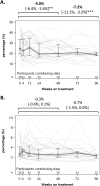Antiretroviral Therapy Reduces T-cell Activation and Immune Exhaustion Markers in Human Immunodeficiency Virus Controllers
- PMID: 31131858
- PMCID: PMC7146008
- DOI: 10.1093/cid/ciz442
Antiretroviral Therapy Reduces T-cell Activation and Immune Exhaustion Markers in Human Immunodeficiency Virus Controllers
Abstract
Background: Despite low plasma human immunodeficiency virus (HIV) RNA, HIV controllers have evidence of viral replication and elevated inflammation. We assessed the effect of antiretroviral therapy (ART) on HIV suppression, immune activation, and quality of life (QoL).
Methods: A5308 was a prospective, open-label study of rilpivirine/emtricitabine/tenofovir disoproxil fumarate in ART-naive HIV controllers (N = 35), defined as having HIV RNA <500 copies/mL for ≥12 months. The primary outcome measured change in %CD38+HLA-DR+ CD8+ T cells. Residual plasma viremia was measured using the integrase single-copy assay. QoL was measured using the EQ-5D questionnaire. Outcomes were evaluated using repeated measures general estimating equations models.
Results: Before ART, HIV controllers with undetectable residual viremia <0.6 HIV-1 RNA copies/mL had higher CD4+ counts and lower levels of T-cell activation than those with detectable residual viremia. ART use was effective in further increasing the proportion of individuals with undetectable residual viremia (pre-ART vs after 24-48 weeks of ART: 19% vs 94%, P < .001). Significant declines were observed in the %CD38+HLA-DR+CD8+ T cells at 24-48 (-4.0%, P = .001) and 72-96 (-7.2%, P < .001) weeks after ART initiation. ART use resulted in decreases of several cellular markers of immune exhaustion and in a modest but significant improvement in self-reported QoL. There were no significant changes in CD4+ counts or HIV DNA.
Conclusions: ART in HIV controllers reduces T-cell activation and improves markers of immune exhaustion. These results support the possible clinical benefits of ART in this population.
Keywords: HIV controllers; antiretroviral therapy; immune activation; immune exhaustion; inflammation.
© The Author(s) 2019. Published by Oxford University Press for the Infectious Diseases Society of America. All rights reserved. For permissions, e-mail: journals.permissions@oup.com.
Figures




Similar articles
-
Immune Activation and HIV-Specific CD8(+) T Cells in Cerebrospinal Fluid of HIV Controllers and Noncontrollers.AIDS Res Hum Retroviruses. 2016 Aug;32(8):791-800. doi: 10.1089/AID.2015.0313. Epub 2016 May 2. AIDS Res Hum Retroviruses. 2016. PMID: 27019338 Free PMC article.
-
Maintenance of Viral Suppression in Human Immunodeficiency Virus Controllers Despite Waning T-Cell Responses During Antiretroviral Therapy.J Infect Dis. 2020 Nov 9;222(11):1837-1842. doi: 10.1093/infdis/jiaa294. J Infect Dis. 2020. PMID: 32496516 Free PMC article.
-
Relationship between T cell activation and CD4+ T cell count in HIV-seropositive individuals with undetectable plasma HIV RNA levels in the absence of therapy.J Infect Dis. 2008 Jan 1;197(1):126-33. doi: 10.1086/524143. J Infect Dis. 2008. PMID: 18171295 Free PMC article.
-
Learning to Be Elite: Lessons From HIV-1 Controllers and Animal Models on Trained Innate Immunity and Virus Suppression.Front Immunol. 2022 Apr 27;13:858383. doi: 10.3389/fimmu.2022.858383. eCollection 2022. Front Immunol. 2022. PMID: 35572502 Free PMC article. Review.
-
Viral, inflammatory, and reservoir characteristics of posttreatment controllers.Curr Opin HIV AIDS. 2021 Sep 1;16(5):249-256. doi: 10.1097/COH.0000000000000699. Curr Opin HIV AIDS. 2021. PMID: 34334614 Review.
Cited by
-
Mortality, Human Immunodeficiency Virus (HIV) Transmission, and Growth in Children Exposed to HIV in Rural Zimbabwe.Clin Infect Dis. 2021 Feb 16;72(4):586-594. doi: 10.1093/cid/ciaa076. Clin Infect Dis. 2021. PMID: 31974572 Free PMC article.
-
Polarization of HIV-1- and CMV-Specific IL-17-Producing T Cells among People with HIV under Antiretroviral Therapy with Cannabis and/or Cocaine Usage.Pharmaceuticals (Basel). 2024 Apr 6;17(4):465. doi: 10.3390/ph17040465. Pharmaceuticals (Basel). 2024. PMID: 38675425 Free PMC article.
-
Meeting an elite controller in a Busy medical OPD!Med J Armed Forces India. 2025 Jan-Feb;81(1):114-115. doi: 10.1016/j.mjafi.2024.04.006. Epub 2024 May 27. Med J Armed Forces India. 2025. PMID: 39872184 No abstract available.
-
Naive infection predicts reservoir diversity and is a formidable hurdle to HIV eradication.JCI Insight. 2021 Aug 23;6(16):e150794. doi: 10.1172/jci.insight.150794. JCI Insight. 2021. PMID: 34228640 Free PMC article.
-
Persistent elite controllers as the key model to identify permanent HIV remission.Curr Opin HIV AIDS. 2025 Mar 1;20(2):165-171. doi: 10.1097/COH.0000000000000907. Epub 2025 Jan 17. Curr Opin HIV AIDS. 2025. PMID: 39773856 Free PMC article. Review.
References
-
- Panel on antiretroviral guidelines for adults and adolescents. Guidelines for the use of antiretroviral agents in adults and adolescents living with HIV. Department of Health and Human Services; Available at http://www.aidsinfo.nih.gov/ContentFiles/AdultandAdolescentGL.pdf Accessed 20 December 2018.
Publication types
MeSH terms
Grants and funding
LinkOut - more resources
Full Text Sources
Medical
Research Materials

